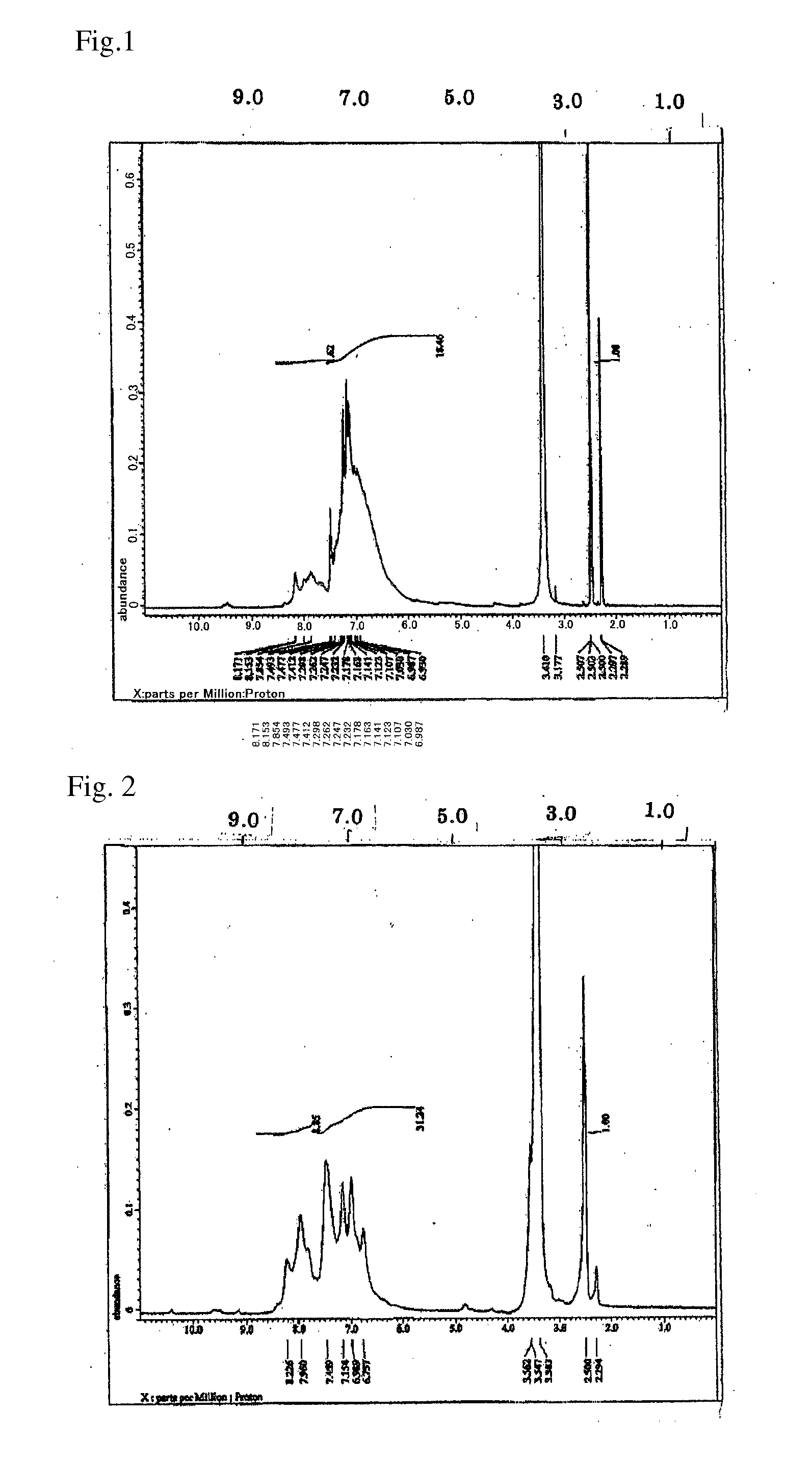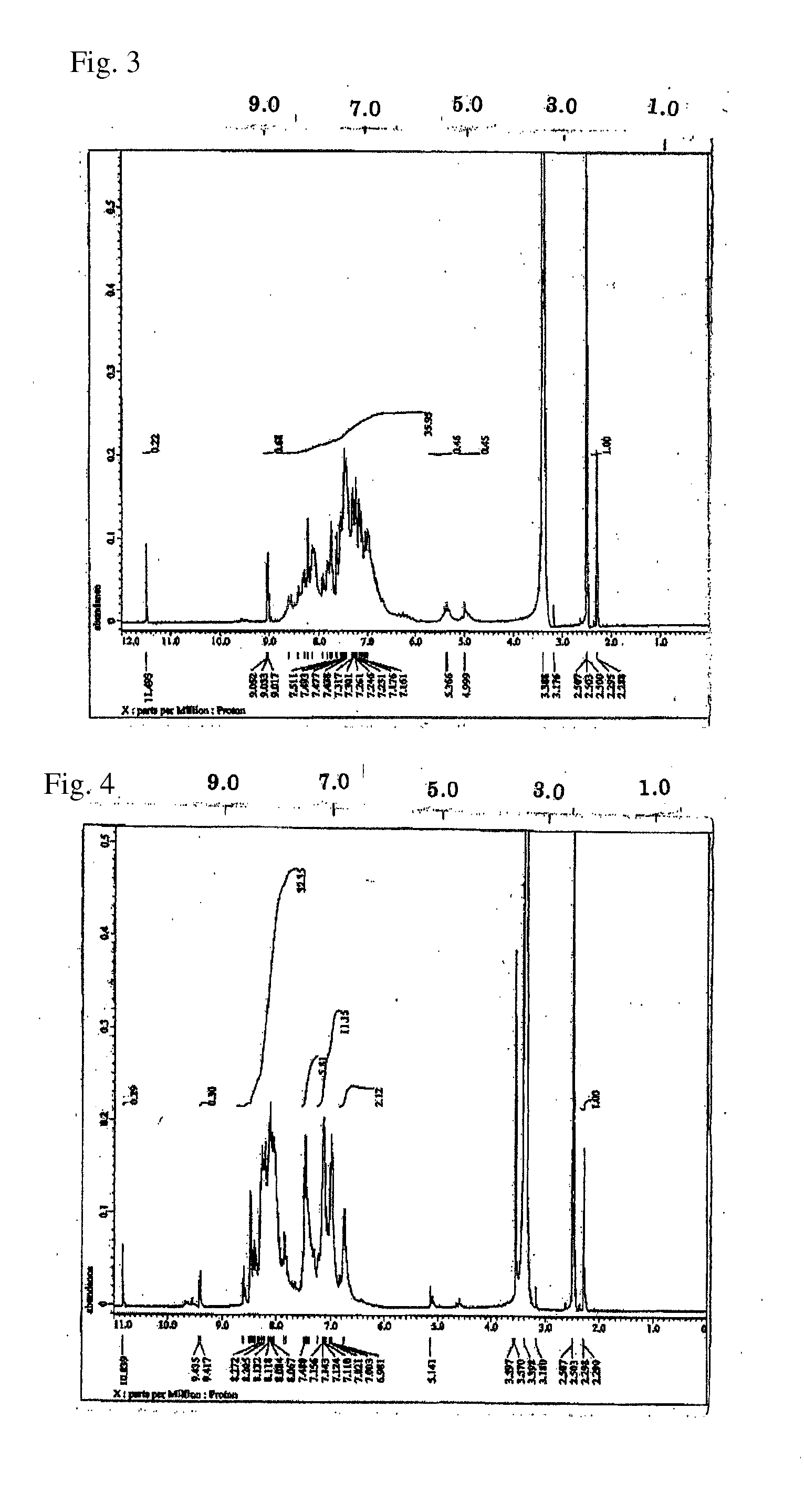Diarylamine novolac resin
a technology of diarylamine and novolac, which is applied in the field of diarylamine novolac resin, can solve the problems of difficult to achieve sufficient film thickness of resist pattern, and achieve the effect of easy and accurate formation, good resist pattern, and efficient suppression of reflection from the substra
- Summary
- Abstract
- Description
- Claims
- Application Information
AI Technical Summary
Benefits of technology
Problems solved by technology
Method used
Image
Examples
synthesis example 1
[0145]N-phenyl-1-naphthylamine (8.00 g, 0.036 mol, manufactured by Tokyo Chemical Industry Co., Ltd.), benzaldehyde (3.87 g, 0.036 mol, manufactured by Tokyo Chemical Industry Co., Ltd.), and para-toluenesulfonic acid monohydrate (0.727 g, 0.0036 mol, manufactured by Kanto Chemical Co., Inc.) were placed in a 100 mL four-neck flask, and then toluene (37.92 g, manufactured by Kanto Chemical Co., Inc.) was added thereto and stirred. The temperature was raised to 110° C. to dissolve the content so that polymerization is initiated. After 12 hours, the content was left to cool to 60° C. and re-precipitated in methanol (400 g, manufactured by Kanto Chemical Co., Inc.). The obtained precipitate was filtered and dried in a vacuum dryer at 50° C. for 10 hours, and then further dried at 120° C. for 24 hours to obtain 8.5 g of the target polymer (represented by Formula (3-13)), hereinafter, abbreviated as pNPNA-BA).
[0146]The weight-average molecular weight Mw of pNPNA-BA measured by GPC was 11...
synthesis example 2
[0147]N-phenyl-1-naphthylamine (10.00 g, 0.046 mol, manufactured by Tokyo Chemical Industry Co., Ltd.), 1-naphthaldehyde (7.12 g, 0.046 mol, manufactured by Tokyo Chemical Industry Co., Ltd.), and para-toluenesulfonic acid monohydrate (0.908 g, 0.0046 mol, manufactured by Kanto Chemical Co., Inc.) were placed in a 100 mL four-neck flask, and then 1,4-dioxane (21.03 g, manufactured by Kanto Chemical Co., Inc.) was added thereto and stirred. The temperature was raised to 110° C. to dissolve the content so that polymerization is initiated. After 12 hours, the content was left to cool to a room temperature and re-precipitated in methanol (400 g, manufactured by Kanto Chemical Co., Inc.). The obtained precipitate was filtered and dried in a vacuum dryer at 50° C. for 10 hours, and then further dried at 120° C. for 24 hours to obtain 11.6 g of the target polymer (represented by Formula (3-14)), hereinafter, abbreviated as pNPNA-NA).
[0148]The weight-average molecular weight Mw of pNPNA-NA ...
synthesis example 3
[0149]N-phenyl-1-naphthylamine (8.00 g, 0.036 mol, manufactured by Tokyo Chemical Industry Co., Ltd.), 9-anthracenecarboxyaldehyde (7.52 g, 0.036 mol, manufactured by Tokyo Chemical Industry Co., Ltd.), and para-toluenesulfonic acid monohydrate (0.727 g, 0.0036 mol, manufactured by Kanto Chemical Co., Inc.) were placed in a 100 mL four-neck flask, and then toluene (37.92 g, manufactured by Kanto Chemical Co., Inc.) was added thereto and stirred. The temperature was raised to 110° C. to dissolve the content so that polymerization is initiated. After 12 hours, the content was left to cool to 60° C. and re-precipitated in methanol (400 g, manufactured by Kanto Chemical Co., Inc.). The obtained precipitate was filtered and dried in a vacuum dryer at 50° C. for 10 hours, and then further dried at 120° C. for 24 hours to obtain 8.5 g of the target polymer (represented by Formula (3-15)), hereinafter, abbreviated as pNPNA-AA).
[0150]The weight-average molecular weight Mw of pNPNA-AA measure...
PUM
| Property | Measurement | Unit |
|---|---|---|
| wavelength | aaaaa | aaaaa |
| wavelength | aaaaa | aaaaa |
| wavelength | aaaaa | aaaaa |
Abstract
Description
Claims
Application Information
 Login to View More
Login to View More - R&D
- Intellectual Property
- Life Sciences
- Materials
- Tech Scout
- Unparalleled Data Quality
- Higher Quality Content
- 60% Fewer Hallucinations
Browse by: Latest US Patents, China's latest patents, Technical Efficacy Thesaurus, Application Domain, Technology Topic, Popular Technical Reports.
© 2025 PatSnap. All rights reserved.Legal|Privacy policy|Modern Slavery Act Transparency Statement|Sitemap|About US| Contact US: help@patsnap.com



